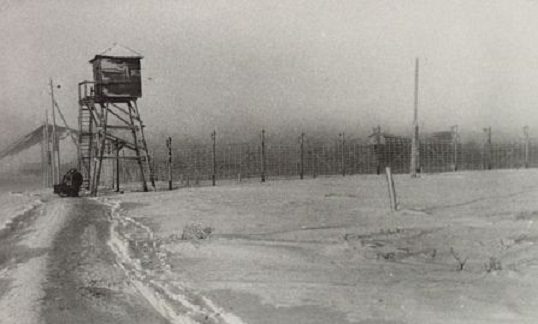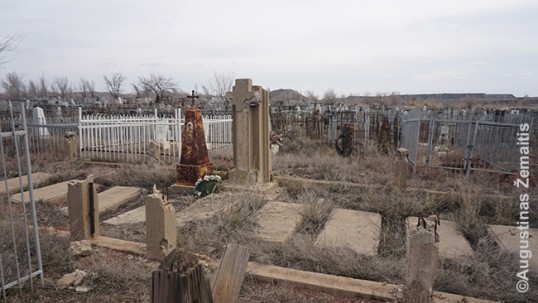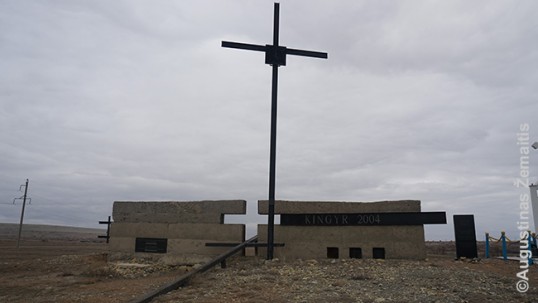Lithuanian exiles and deportations (1940-1953)
In 1940, the Soviet Union has occupied Lithuania, launching the Soviet Genocide.
While tens of thousands of people were killed outright by the Soviets, it was the Exiles that became the face of the tragedy. In the Exiles, entire families would be put into cattle carriages and moved to prisons and villages in the least hospitable parts of the Soviet Union. Some half died there because of executions, cold weather, or malnutrition.
Hundreds of thousands of Lithuanians were exiled this way. In just a single week of June 1941, for example, the Soviet Union has exiled 2% of the entire Lithuania’s population, while the total number stood at nearly 14%.

A family goes to their fate in a cattle carriage
These exiles are deeply etched into the Lithuanian psyche and nearly every Lithuanian has at least a single relative who was exiled.
This article explains what it was to be a Soviet exile, and also provides information on other similar contemporary experiences such as the Nazi German persecutions, Soviet evacuations, and fleeing Lithuania as refugees.

Statistics of people lost to Lithuania 1940-1959, both per event and per perpetrator. The tables are compiled consulting multiple sources (turmoil and subsequent propaganda made the exact figures impossible to find out, so approximations vary somewhat per source. Moreover the boundaries of Lithuania switched multiple times in the era). The per-event table lists the murdered and the refugees/deportees in separate rows where possible; where impossible they are put together and the approximate share of those killed is provided instead (most/many/some).
Why were people exiled from Lithuania?
Soviets undertook a genocide aimed at certain groups in the Lithuanian population: the religious Christians, the Lutherans, the rich, the intellectuals, the patriots. Soviet dictator Joseph Stalin viewed these groups as the "vilest" ones and wanted to eradicate them in order to make the occupation of Lithuania eternal.
At one time, an idea was floated to murder or exile the entire Lithuanian nation, as Soviets did to some other ethnic groups, such as Chechens (Lithuanian affairs commissioner Mikhail Suslov: "There will be Lithuania - but without Lithuanians"). However, eventually, this idea was dropped in favor of targetting narrower parts of the Lithuanian nation based on their love for Lithuanian culture, religion, and social class.

Exiled Lithuanians at a transhipment camp en-route
As this was a part of genocide rather than a form of political persecution, the targetted groups would be expelled as a whole: if the person was from a family of the persecuted group, his/her own beliefs did not matter. In fact, a third of those expelled were children and newborns who happened to be born to parents of the persecuted groups. Even where beliefs did matter, little evidence was needed to prove them: ownership of a Lithuanian flag or a membership of the boy scouts may have been enough of a proof of patriotism/religiosity for deportation or murder. In other cases, some people would be either tortured to give away others or rewarded for such collaboration; in these cases, the interrogated person would often lie to end tortures or get a reward, that way condemning another person for deportation.
Special case: Nazi Germany Nazi Germany that has occupied Lithuania in 1941-1944 perpetrated its own genocide, targetting the Jews. Nazi Germany has also expelled significant numbers of people to concentration camps or forced labor. However, due to the end of World War 2, this experience was short and people were either killed or liberated by ~1944. Nazi German genocide is thus typically not treated as Exile but rather as outright murders (even if a person was moved to some death camp abroad to be murdered) or as temporary imprisonment/persecution (for those who were freed). "Exiles" in Lithuania are thus synonymous with Soviet policies.
Special case: Evacuations As Nazi Germany attacked the Soviet Union in 1940, the Soviet Union has evacuated some of its most loyal collaborators so they would not be punished. This was a mirror image of the exiles: the evacuees were saved from punishment this way rather than persecuted.
Special case: Fleeing Knowing what the Soviet occupation had in store of them, hundreds of thousands have fled Lithuania beforehand in 1944. They are considered a separate group known as DPs or the Second Wave of Lithuanian emigration, however, to themselves, they were as much "the exiled ones" as those in Siberia as they would have never left Lithuania otherwise.
How many people were exiled from Lithuania?
Soviets have exiled some 350 000 to the inhospitable parts of the Soviet Union and the labor camps, many of them perishing.
This number does not include the "Special cases" that are not considered parts of exiles but are closely related (their numbers are written below).
Special case: Nazi Germany Nazi Germany expelled some 20 000 ethnic Lithuanians to concentration camps and 30 000 for forced labor. Between the census years 1923 and 1959, the number of Jews in Lithuania declined by 200 000 during that time but this includes not only those expelled to concentration camps but also those killed locally, those who died resisting Nazi Germany, those who successfully fled Lithuania before/during/after WW2 or were exiled/evacuated by the Soviet regime.
Special case: Evacuations Soviet Union has evacuated some 30 000 collaborators in 1940.
Special case: Fleeing Some 200 000 - 300 000 people fled to the west from Lithuania (including Klaipėda region).
Where were the people from Lithuania expelled to?
Soviet Union mostly exiled people to the far-away parts of Russia (Siberia, Far East and north) - 80% of those exiled.

Exiled Lithuanians in a Siberian village
The remaining 20% were exiled to Kazakhstan.
Several thousand were exiled to Tajikistan.
What was life like for exiled Lithuanians?
Many have died en-route, unable to withstand the crowded transportation in cattle carriages. Children, a third of deportees, suffered the most.
If they survived the journey, depending on the place of the exile, they had two fates:
(1)Those who were expelled to Gulags (mostly men): prison camps were forced to work endlessly: e.g. dig coal or build railways through inhospitable tundra. Hard work, lack of food, regular executions and murders of the prisoners, and other reasons meant the majority of these victims died while in Gulag.

Entrenched Gulag near Vorkuta
(2)Those who were expelled to inhospitable cold Soviet villages of Siberia, northern Russia, or the Russian Far East (mostly entire families) simply had to live there starting from scratch: building their own shack, trying to find food. Many of the local Russians despised them as the Soviet Union claimed them to be “fascists”, yet some locals have helped them to survive. In these villages too, many have died unable to survive the cold or hard work, but the majority did survive as the conditions were still better than in Gulags. Note: sometimes, when talking about "Exiles", only this group is considered, while the Gulag prisoners are considered to have been imprisoned rather than exiled. In this article we, just like the majority of Lithuanians, use the word "Exiles" to cover both fates. If you, however, ever see a claim that, for example, less than 200 000 Lithuanians were exiled, this is because those exiled to Gulags are not counted in that number..

A typical 'house' in a cold village of Siberia where the exiled people lived at
If they survived until 1953 when Stalin died and Khrushchev became the leader of the Soviet Union, most of them were suddenly declared “rehabilitated”: even the Soviet regime recognized they were expelled for no reason.
So, they were slowly getting permission to leave the places of exile. Whoever could return, returned to Lithuania, typically having to start from scratch again as the homes that were taken from them were not returned. Those who wasted their youths in exile typically spent their lives underemployed, as they still remained undesirables in many Soviet workplaces. Some 17 000 were allowed to return to Lithuania by 1956 and 80 000 returned by 1970.
Some of the exiles, however, were still not allowed to return to Lithuania but could move to other parts of the Soviet Union. Often, the ones who were exiled for their ethnicity, religion, social class, education, or opinions, were allowed to return to Lithuania, but those who also had performed pro-Lithuanian actions (e.g. anti-Soviet guerillas, pre-occupation Lithuanian politicians) were not allowed to return. Many of those not allowed to return settled in Latvia or Kaliningrad Oblast to be close to Lithuania.
And yet a few decided to remain in their places of exile: mainly because of frail health or family reasons (e.g. they married someone there). Such “remainers” were too few in numbers, however, to actually continue as a Lithuanian community of any form; besides, any formal Lithuanian organization was banned by the Soviets outside Lithuania.
Special case: Nazi Germany. Those who survived Nazi German concentration camps and forced labor had two choices in 1945 after they were liberated: to go back to Soviet-occupied Lithuania (where they were likely to be persecuted again) or to try to move to the Western World, thus joining the Second Wave of Lithuanian migration. Whoever could, often chose this option, although that possibility also depended on their location (whether, for example, their camp/labor site was located in West Germany, East Germany, or Poland).
Special case: Evacuations. The Soviet collaborators who were evacuated by the Soviet Union in 1940, on the other hand, lived good lives while in evacuation and were typically sent back to Lithuania after Lithuania was reoccupied by the Soviets in 1944 and were given important positions there. By that time, they were even more detached from Lithuanians and influenced by the Soviet Union. Many evacuees "of lesser importance" did not return, however, mostly staying in the other parts of the Soviet Union and integrating there.
How did the children and grandchildren of exiled Lithuanians live?
The children born in the places of exile had the Exile experience imprinted on them even if they came back to Lithuania after 1953. They continued to be discriminated against by the Soviet regime and, as the 1990 independence approached, they, still quite young, were generally instrumental in vocalizing the plight of their parents and themselves in the Siberia of 1940s. As Russia and Kazakhstan were opening up, these "children of the exile" organized trips there to commemorate the plight of their (grand)parents as well as to discover and take their bones back to Lithuania.
Those who did not move back to Lithuania after 1953 often integrated into the local communities, speaking Russian to their own children. Some of them did eventually return to Lithuania after 1990 when Lithuania made it a priority to invite the remaining exiles back, even building them free apartments.
In a few places, descendants of the exiled ones managed to form Lithuanian organizations after the collapse of the Soviet Union. In Kazakhstan, where the memory of the exiles is cherished and respected, parts of these descendants started being proud of their forefathers' high moral standing and place in the elite of Lithuania for which they were persecuted.
What heritage the exiled Lithuanians left?
They could leave only crumbling graves after them.
In the case of Gulags, the prisoners would be buried in secret common graves without any markings. In the case of those exiled to villages, they would sometimes establish improvised humble Lithuanian cemeteries. As their families died out or moved away though, the cemeteries became uncared for.

A group grave of Lithuanians who remained in Kazakhstan (village of Rudnyk) after surviving Gulag
After the independence of Lithuania, the exiles became a symbol of the Lithuanian tragedy under the Soviet occupation. At first, the descendants of those exiled or their relatives would search for their relative graves, repatriating them to Lithuania if possible or otherwise marking them with improvised memorials. As even that generation became frail and began dying out the “Misija Sibiras” program began where Lithuanian youths would visit the cemeteries.
While Russia, still in Soviet-Genocide-denial, has curbed any memorialization of the Lithuanian exiles, numerous monuments were constructed in Kazakhstan by the Lithuanians and Lithuanian-Kazakhstanis. The story of Lithuanians (among other exiles) is also told in museums there, such as that of Dolinka.

Kingyr Gulag Lithuanian memorial. A Vyšniūnas, M. Kurtinaitis, 2004.
The heritage of the exiled Lithuanians is also commemorated in many Museums of occupation and resistance that dot the Lithuanian cities and towns.



September 26th, 2020 - 13:21
Thank you for sharing. I had at least one Stravinskas relative die in a Gulag. The ‘official’ Soviet reason was because of a heart attack, which probably meant he was shot in the heart.
March 15th, 2022 - 08:32
Thank you! Good article.
September 28th, 2022 - 17:11
I am interested in finding any information relative to an Erica Andersova, a Lithuanian who appears to have survived a Nazi labor camp, and was listed among those at a DP Camp in Erlangen, West Germany in 1946. Her parents were Kolo Damen Andersova and Emilia Gidion.